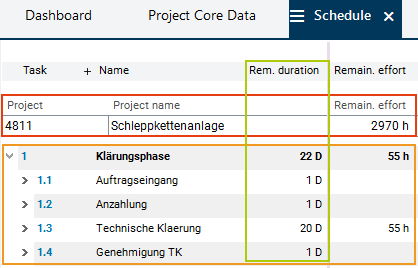The documentation from version 39.5.17 of PLANTA project can be found in the new PLANTA Online Help .
.
Module
Module Structure: Interface
Module components- Module title
- contains the name of the module.
- Data windows
- subdivide module data for the sake of clarity.
- As a result, data fields can be contained in one or several windows (maximum 3).
- If required, you can display or hide a data field within a window.
- Data fields
- contain data
- can have different data field behavior.
- Scrollbar
- As soon as the data cannot be displayed completely, vertical or horizontal scroll bars are displayed.
Module Structure: Technology + Logic
Information- From a technical point of view, a module consists of data areas which in turn contain data fields from data tables.
- From a userís point of view, a module consists of records.
- A record summarizes attributes/parameters of an object with their corresponding values.
- Values are displayed in separate data fields.
- What data fields belong to a record (record structure) is defined by the customizing of the corresponding data area.
- A record can be displayed differently on the interface: in the form of a line (horizontal layout), in the form of a column (vertical layout), or arranged arbitrarily (in forms).
- The same data field over several records forms a data logical column.
- Depending on the layout, a data logical column can consist of the visualization of a column (horizontal layout), a line (vertical layout) or a form from the field which is always at the same position across all records.
- If there is only one record in a data area, one column = one data field.
- Here, six records are displayed: one project record and five task records.
- The project record consists of three data fields (Project, Project name and Remaining effort), and their corresponding values.
- The task records consist of four data fields (Task, Task name, Remaining duration, and Remaining effort) with the corresponding values.
- All Remaining duration fields form a column. The data logical Remaining duration column equates to the layout column.
- Caution with Remaining effort: Although optically it looks like one column (due to the layout positioning and the same name), they really are two columns: one Remaining effort column of the project record and the Remaining effort column of the task records.
| I | Attachment | History | Size | Date | Comment |
|---|---|---|---|---|---|
| |
Module.PNG | r1 | 11.0 K | 2021-02-05 - 10:57 | |
| |
modulmark.png | r1 | 8.9 K | 2021-02-05 - 10:57 |



